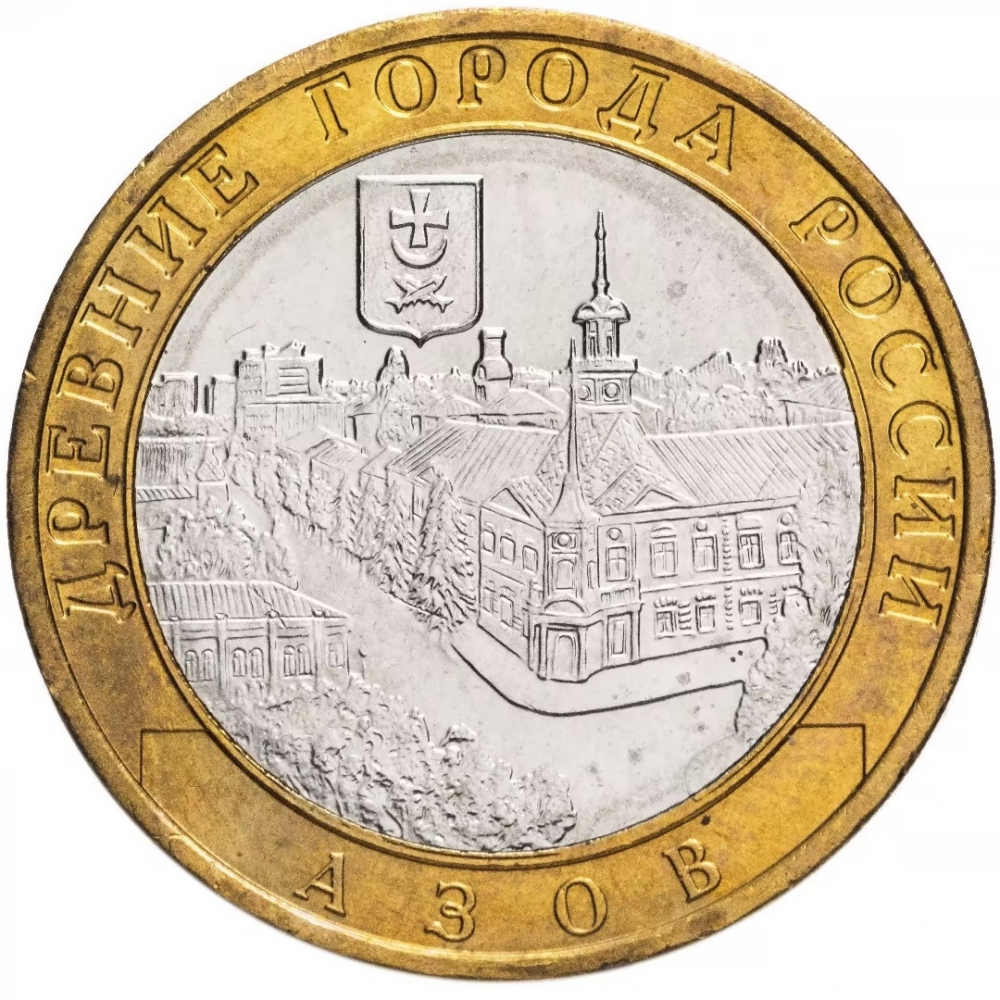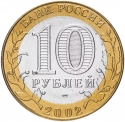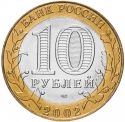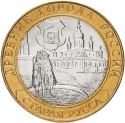You are about to finish your registration. Please check your mailbox (including spam folder). There should be a letter with a confirmation link. Check setting to make sure that your e-mail address is correct.
Send letter againDescription
In 2002 the Central Bank of the Russian Federation began an annual program that each year commemorates some of their historical towns on bi-metallic 10 Ruble coins. The coins picture the city and its arms on one side and has the standard Russian 10 Ruble obverse on the other. Unlike a lot of coin programs throughout the world there is no set regularity to the number of coins released each year in this series, with some years seeing 4 coins issued and other years only 3.
Azov, formerly known as Azoff, is a town in Rostov Oblast, Russia, situated on the Don River just 16 kilometers (9.9 mi) from the Sea of Azov, which derives its name from the town.
In the 10th century, as the Khazar state disintegrated, the area passed under control of the Slavic princedom of Tmutarakan. The Kypchaks, seizing the area in 1067, renamed it Azaq (i.e., lowlands), from which appellation the modern name is derived. The Golden Horde claimed most of the coast in the 13th and 14th centuries, but the Venetian and Genoese merchants were granted permission to settle on the site of modern-day Azov and founded there a colony which they called Tana (or La Tana).
In 1471, the Ottoman Empire gained control of the area and built the strong fortress of Azak (Azov). The fort blocked the Don Cossacks from raiding and trading into the Black Sea. The Cossacks had attacked Azov in 1574, 1593, 1620, and 1626. In April 1637, three thousand Don Cossacks and four thousand Zaporozhian Cossacks besieged Azov (the Turks had four thousand soldiers and two hundred cannons). The fort fell on June 21 and the Cossacks sent a request to the Tsar for re-enforcements and support. A commission recommended against this because of the danger of war with Turkey and poor state of the fortifications. In March 1642, Sultan Ibrahim issued an ultimatum and Tsar Mikhail ordered the Cossacks to evacuate. The Turks reoccupied Azov in September 1642.
During the Azov campaigns of 1696, Peter the Great, who desired naval access to the Black Sea, managed to recover the fortress. Azov was granted town status in 1708, but the disastrous Pruth River Campaign constrained him to hand it back to the Turks in 1711. A humorous description of the events is featured in Voltaire's Candide. During the Great Russo-Turkish War, it was taken by the army under Count Rumyantsev and finally ceded to Russia under the terms of Treaty of Kuchuk-Kainarji (1774). For seven years Azov was a seat of its own governorate, but with the growth of neighboring Rostov-on-the-Don it gradually declined in importance.
Obverse

|
In the centre of the disc indication of the denomination of the coin: 10 RUBLES, inside of the figure 0 hidden pictures of the number 10 and of the inscription RUB visible by turns on changing the angle of vision, in the lower part of the disc the mint trade mark MMD, on the ring along the rim above the inscription: BANK OF RUSSIA, below the year of issue 2008, to the left and to the right stylized twigs of plants going over to the disc. БАНК РОССИИ |
|---|---|
Reverse

|
Depicts an architectural panorama of the town, above the coat of arms of Azov, over it on a ribbon the semicircular inscription: ANCIENT TOWNS OF RUSSIA, below the inscription along the rim AZOV. ДРЕВНИЕ ГОРОДА РОССИИ |
| Edge |
300 corrugations and the inscription ДЕСЯТЬ РУБЛЕЙ (TEN RUBLES) recurring twice and divided by asterisks ДЕСЯТЬ РУБЛЕЙ ⋆ ДЕСЯТЬ РУБЛЕЙ ⋆ |
Characteristics
| Type | Commemorative Issue (Circulating) |
| Material | Bi-Metallic |
| Ring | Brass |
| Center | Cupronickel |
| Weight | 8.4 g |
| Diameter | 27 mm |
| Thickness | 2.1 mm |
| Shape |
|
| Alignment | Medal |
| Mints |
Moscow Mint (MMD) Saint Petersburg Mint (SPMD)
|







